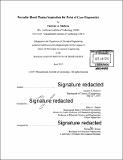Portable blood plasma separation for point of care diagnostics
Author(s)
Shatova, Tatyana A
DownloadFull printable version (22.86Mb)
Other Contributors
Massachusetts Institute of Technology. Department of Chemical Engineering.
Advisor
Klavs F. Jensen.
Terms of use
Metadata
Show full item recordAbstract
Point of care testing is expanding the healthcare field towards personalized and early-detection medicine. Microfluidic platforms present an opportunity for low cost, portable diagnostic sensors through manipulation of small volumes of fluids on isolated, compact devices. One of the challenges of microfluidic sensors is the biological sample pretreatment steps that are manually performed prior to on-chip loading and sensing. This issue is especially prominent for human blood, which contains about a billion cells in one milliliter total volume. These blood cells can rupture, clog devices, block optical readouts, and foul electrodes. At the same time, the liquid portion of human blood, plasma, is rich in a variety of disease indicators, many of which have not yet been identified, and thus is an essential part in the diagnostic field. This thesis focuses on the design of a small, around 1 cm long, microfluidic device that separates out blood plasma from undiluted human blood. This design does not require any external field or equipment, beyond a loading syringe and collection tubing. The separation results show 10-100 times improvement in plasma purity over the literature values for passive separation designs. This separation system was then combined with a colorimetric malaria sensor that produced a visually detectable colored result with a 7.5 nM limit of detection in whole blood. This thesis details the design of a low power point of care diagnostic process that is capable of blood processing and detection, and which eliminates the need for any external laboratory-scale equipment. Advantages and challenges of other low power, microfluidic sensor constructs are also discussed.
Description
Thesis: Ph. D., Massachusetts Institute of Technology, Department of Chemical Engineering, 2015. Cataloged from PDF version of thesis. Includes bibliographical references (pages 127-136).
Date issued
2015Department
Massachusetts Institute of Technology. Department of Chemical EngineeringPublisher
Massachusetts Institute of Technology
Keywords
Chemical Engineering.